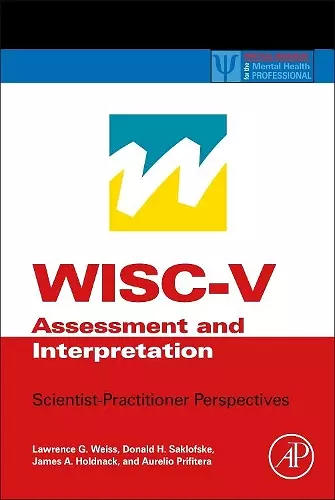WISC-V Assessment and Interpretation
Scientist-Practitioner Perspectives
Donald H Saklofske author Lawrence G Weiss author Aurelio Prifitera author James A Holdnack author
Format:Hardback
Publisher:Elsevier Science Publishing Co Inc
Published:4th Jun '15
Currently unavailable, and unfortunately no date known when it will be back

The only book describing the clinical use and interpretation of the new WISC-V test
The Wechsler Intelligence Scale is the most widely used intelligence test for children worldwide. WISC-V introduces new subtests, composite scores, process scores, error scores, and scaled scores as a more complex and accurate means of assessing cognitive abilities. WISC-V Assessment and Interpretation provides practical information for clinicians on selection of subtest measures, administration, and interpretation. New subtests are described along with tips for accurate administration and scoring. Full Scale IQ is identified as important for predicting relevant behaviors, and primary index scores for characterizing the child’s strengths and weaknesses. Classroom indicators of low scores on each of these abilities are identified, with suggested interventions, accommodations, and instructional strategies for low scorers. Coverage includes ethnic differences for the Full Scale IQ and each primary index score, along with evidence of the profound influence of parental attitudes and expectations. Several other societal and contextual factors relevant to understanding racial/ethnic differences are presented. Two chapters review use of the WISC-V for identifying learning disabilities, testing of individuals with dyslexia, and best-practice recommendations to ensure accurate diagnosis and intervention. Concluding chapters describe advances in the Q-interactive system platform allowing administration of the WISC-V on iPads and other tablets and how clinicians can tailor assessment using select WISC-V subtests and features.
"... a valuable addition to a practitioner’s library... an important resource that will certainly help practitioners use these data to make meaningful interpretations, and to recommend targeted interventions and accommodations." --Journal of Psychoeducational Assessment "WISC-V Assessment and Interpretation: Scientist-Practitioner Perspectives is a new book that provides comprehensive and detailed information on the use and interpretation of the Wechsler Intelligence Scale for Children–Fifth Edition (WISC-V; Wechsler, 2014)…The book contains 12 chapters highlighting applied, theoretical, and clinical considerations related to the WISC-V and directions for research. Consistent with its title, the book provides practical resources for professionals regarding administration and interpretation of the WISC-V… The authors offer insightful recommendations for best practices in cognitive assessment. Generally, the layout of the book is clear, concise, and written with a diverse audience in mind. In addition, the use of figures and tables throughout each chapter also helps enhance overall readability. One particular area of strength in this book is the consistent use of examples and analogies to help deepen the understanding of complex concepts…The book also offers several features that may be particularly useful for less experienced professionals, such as the inclusion of a "Frequently Asked Questions" section, lists of interventions and accommodations recommended for specific areas of deficit/strength, and the inclusion of general and specific administration and scoring guidelines that are likely useful for student readers, new professionals, and those who are unfamiliar with the WISC-V. It can also be a handy resource in academic settings as a tool in the instruction of effective and appropriate cognitive assessment of children with diverse needs. The book also contains plenty of useful information for more experienced professionals, such as descriptions of each new WISC-V subtest and the appendix outlining major differences between the WISC-IV and WISC-V. The chapters are well organized and are written to be accessible to both students and seasoned clinicians. Another helpful feature of the book is the frequent suggestions of additional resources in situations where more extensive coverage of a particular topic may be desired. In addition, the inclusion and frequent reference to recently published literature is another strength. Given that the WISC-V was published fairly recently, this book is both timely and relevant, and it is the only resource on the WISC-V to date… Taken together, this book provides readers with superior recommendations for best practice in the administration, scoring, and interpretation of the WISC-V. Based on the quality of information presented in this book, it is surely to be a valuable resource for a wide range of professionals using the WISC-V in professional practice." --Reviewed by Adam W. McCrimmon and Keely A. Murphy, University of Calgary for Canadian Journal of School Psychology
ISBN: 9780124046979
Dimensions: unknown
Weight: 840g
456 pages